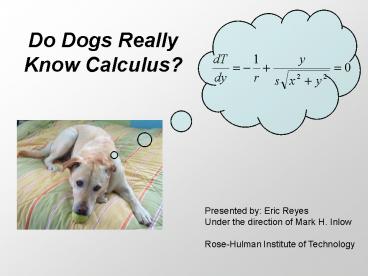Do Dogs Really Know Calculus PowerPoint PPT Presentation
1 / 33
Title: Do Dogs Really Know Calculus
1
Do Dogs Really Know Calculus?
Presented by Eric Reyes Under the direction of
Mark H. Inlow Rose-Hulman Institute of Technology
2
Overview
- The story of a professor and his dog
- A standard approach
- The hurdle
- Measurement error
- Learning to jump as we run
- Two approaches
- Application
3
Background
(courtesy of Tim Pennings)
4
Data Collection
Lake Michigan
Ball
Starting Point
Elvis Enters Water
Tape Measure
Beach
5
Lake Michigan
Ball
B
Where r running speed s swimming speed
Elviss starting point
A
C
D
Beach
6
Derivation of Optimal Path
- Collected 5 observations of Elviss running and
swimming speeds - Used an average of 3 best times to compute
running speed (r) and - swimming speed (s)
- Found derivative of Time function, and solved
for y using values of r and s - calculated above
7
Derivation of Optimal Path
8
Derivation of Optimal Path
9
Derivation of Optimal Path
10
(No Transcript)
11
(No Transcript)
12
What Does it Mean to Know Calculus?
- On Average, Elvis performance jitters about
his optimal path
(Simulation)
13
Simple Linear Model
Model
Deterministic
Stochastic
14
(No Transcript)
15
Does Elvis Really Know Calculus?
16
(No Transcript)
17
Measurement Error
Model
observed x value
true x value
measurement error
The measurement error will bias the slope toward
zero.
(Simulation)
18
First Approach
Because of the data collection methods, we test
for the presence of measurement error using a
different estimator for the slope.
Therefore, this estimate is consistent,
regardless of measurement error.
19
Assumptions
- Expected value of error in xs equal to 0
- Y-intercept of zero
- Independent observations
20
(No Transcript)
21
(No Transcript)
22
Does Elvis Really Know Calculus?
23
Second Approach
- Do not put your faith in what statistics say
until you have carefully considered what they do
not say. - - William Watt
24
Second Approach
Since we desire to remove the assumption that the
intercept is zero, we use a top-third,
bottom-third slope estimator.
Therefore, this estimate is also consistent,
regardless of measurement error.
25
Assumptions
- Expected value of error in xs equal to 0
- Independent observations
26
(No Transcript)
27
(No Transcript)
28
Question
- How do we test if intercept is zero?
29
Results
- The value of a problem is not so much coming up
with the answer as in the ideas and attempted
ideas it forces on the would be solver. - - I.N. Herstein
30
Results
- After top-third, bottom-third created, we end up
with a small sample size
31
Does Elvis Really Know Calculus?
32
Applications
- Correlation between breast-cancer incidence and
saturated-fat intake - The method for determining proper dieting is a
self-report form. This has a lot of
measurement error (Rosner). - Any observational data that depends on
self-reported results.
33
All this over a game of fetch?
Questions?
(Courtesy of Tim Pennings)

